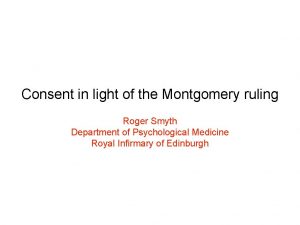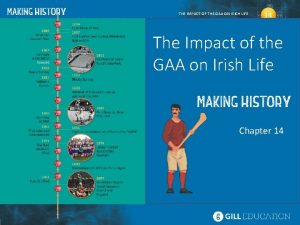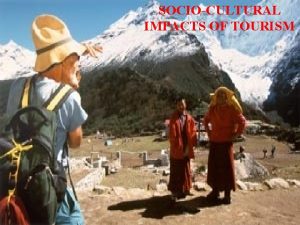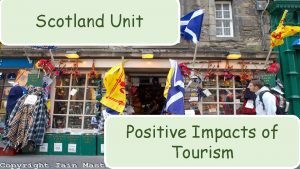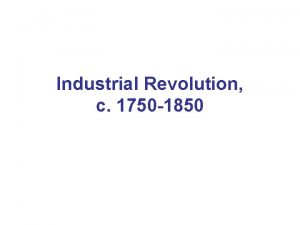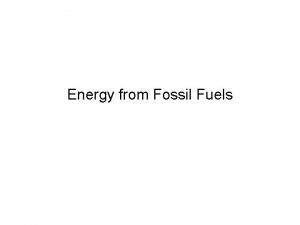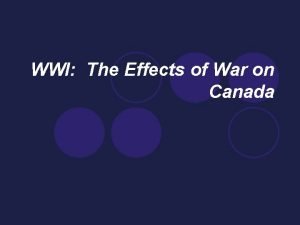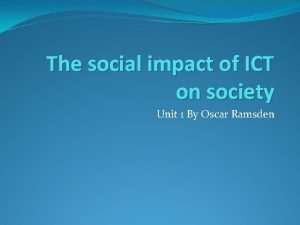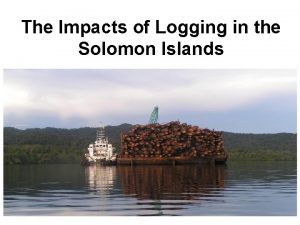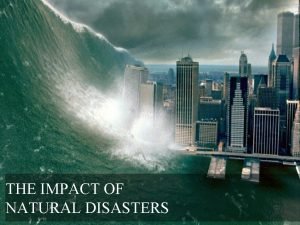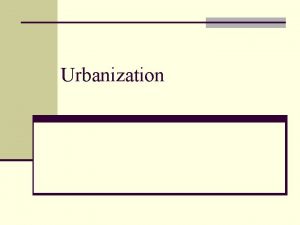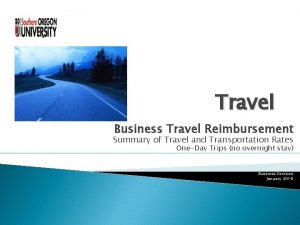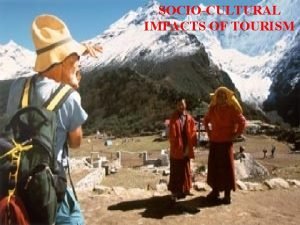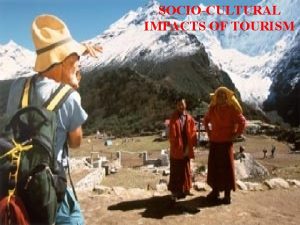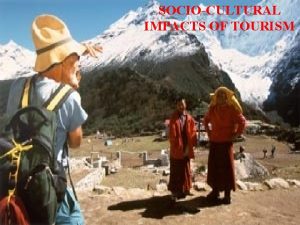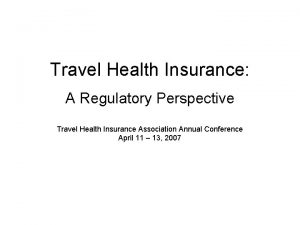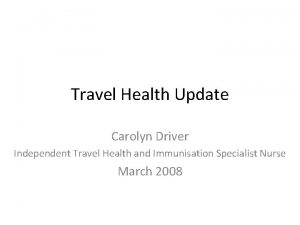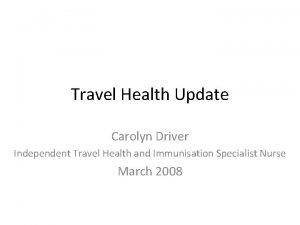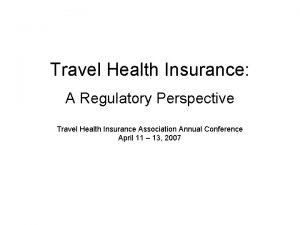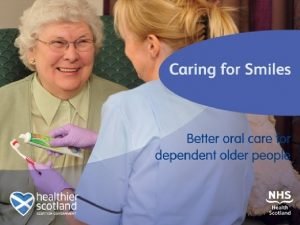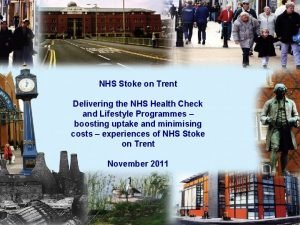Measuring the Health impacts of NHS travel Health


























- Slides: 26

Measuring the Health impacts of NHS travel Health Outcomes of Travel Tool Rick Lomax NHS England / Public Health England Sustainable Development Unit Mike Holland EMRC Mike. holland@emrc. co. uk www. sduhealth. org. uk

Sustainable Development Unit Supports organisations across health and care sector to embed and promote sustainable development in order to reduce emissions, save money and improve the health of people and communities. The SDU develops tools, policy and research to promote sustainable development and adapt to climate change within the Health and social care sector. www. sduhealth. org. uk

Measuring impacts of travel As a system we are very good at calculating CO 2 e / Greenhouse Gases of travel. Travel represents 13% of all Health and Social Care sector emissions; 13% Travel 15% 72% Building energy Procurement www. sduhealth. org. uk Travel being; Owned fleet Grey fleet Patient transport services Patient travel Staff commute Ambulances

Measuring impacts of travel Royal College of Physicians Every breath we take: the lifelong impact of air pollution report • 40, 000 deaths are attributable to exposure to outdoor air pollution • Cost of air pollution to the UK annually is over £ 20 bn NHS Constitution; All staff should “do all you can to protect patients from avoidable harm”

Virtuous circle – Health and Travel e. g. more sustainable transport systems More investment in health promoting systems + public infrastructure Less dependence of formal health and social care system www. sduhealth. org. uk Less air pollution, less road trauma, more physical activity, fewer overweight/obese people Lower levels of long term, multiple preventable conditions Adds more life to years, not just years to life Improves public health, reduces inequalities

The Health Outcomes of Travel Tool • Objectives – To quantify the total health effects from travel related to the NHS from: • • • Air pollution Traffic accidents Noise Greenhouse gases Active transport – To enable NHS organisations to calculate: • Their own impacts • The benefits of plans for improving transport

Scope • Things that move because of the NHS – – – Ambulances Patients Visitors Staff Goods • Burdens on health and the environment – – – Local / regional air pollution Air pollution Traffic accidents Noise Greenhouse gases Inactive transport • Timeframe – 2015 - 2030 m

Structure of HOTT • Series of Excel worksheets, as follows: – Title – User interfaces for different types of organisation: • Ambulance Trusts • Hospital, mental health and other Trusts • Primary care (by CCG) – Background calculations for each type of organisation – Data from external sources • Staff numbers, business mileage, accident rates, emission factors, etc.

User interfaces

User interfaces

Background calculations

Background calculations

Data from external sources

Data from external sources

Impact calculations • Air pollution emissions – Calculated using Df. T and NAEI emission factors per vehicle km for diesel, petrol, electric – Adjustments provided for future years as technology improves

Impact calculations • Air pollution impacts – Activities of each Trust (etc. ) allocated to specific area types adopted by Defra’s damage per tonne estimates for transport – Note: these values are incomplete and subject to revision

Impact calculations • Air pollution impacts – Emissions multiplied by damage per tonne estimates specific to the area type for each Trust, CCG, etc. – Deaths, life years lost, hospital admissions back-calculated from the damage costs • Quality rating: Medium. Several uncertainties, but constrained by national estimates.

Impact calculations • Greenhouse gas burdens – Fuel consumption (diesel, petrol, electric) calculated from mileage – Factors applied to reflect: • Changes in vehicle fleet to 2030 • Changes in vehicle efficiency to 2030 – Fuel consumption multiplied by well to wheel emission factors (including changes to 2030) – Emissions multiplied by DECC non-traded values per tonne – No QALY estimate • Quality rating: – Medium-high: Emissions linked closely to fuel use, DECC values accepted in Government

Impact calculations • Accidents – – – Df. T data on fatalities, serious injuries, minor injuries, vehicle km By Local Authority Averaged over last 5 years Conversion to QALYs and £ using Df. T factors Accident rates per v. km assumed constant to 2030 • Quality rating: – High overall, based on detailed statistics, would be improved by specific data from Ambulance Trusts

Impact calculations • Noise – Application of single damage cost per v. km for non -rural travel from Df. T – Back-calculate to derive estimate of QALYs , using £/QALY data from Df. T • Quality rating: – Low, but estimated impacts are small

Impact calculations • Fitness benefits of Active Travel (cycling, walking) – Applied to staff commuting only – Df. T data on % of healthcare staff travelling by different modes – Response functions from WHO HEAT Tool applied to distance travelled – Valued using Df. T £/QALY estimate • Quality rating: – Medium-low: Available travel data are highly aggregated

Indicative results (not final) • Economic values, all burdens combined (air, GHGs, accidents, noise)

Indicative results (not final) • QALYs, all burdens combined (air, accidents, noise) except GHGs

Indicative results (not final) • Share of total economic value by impact category

How indicative are these results? • Have yet to be thoroughly checked • Some additional activities are yet to be factored in – Some commuting – Primary care business travel – Delivery of goods

Final comments • The UK’s health sector accounts for between 3 and 5% of traffic • This generates a significant burden on society, so we need to understand the problem and optimise • Opportunity to influence other sectors: interest of some local authorities has been noted
 Tasmin v barts health nhs trust
Tasmin v barts health nhs trust Positive impacts of materials technology
Positive impacts of materials technology Positive impacts of materials technology
Positive impacts of materials technology Positive impacts of information technology
Positive impacts of information technology Negative social impacts of tourism
Negative social impacts of tourism Explain the social impact of ict
Explain the social impact of ict Long term impacts of the industrial revolution
Long term impacts of the industrial revolution Impact of the gaa on irish life
Impact of the gaa on irish life Impacts of the haitian revolution
Impacts of the haitian revolution Minoxfen
Minoxfen Negative social impacts of tourism
Negative social impacts of tourism Positive impacts of tourism in scotland
Positive impacts of tourism in scotland Positive impacts of ict
Positive impacts of ict What are causes of inflation
What are causes of inflation Effects of industrial revolution
Effects of industrial revolution Long term impacts of the industrial revolution
Long term impacts of the industrial revolution Major rishi nair
Major rishi nair What are the environmental impacts of fossil fuels
What are the environmental impacts of fossil fuels Golden triangle commercialisation
Golden triangle commercialisation Positive and negative effects of ww1 on canada
Positive and negative effects of ww1 on canada Social impact of ict
Social impact of ict Social impacts of logging in solomon islands
Social impacts of logging in solomon islands Environmental effect of disaster
Environmental effect of disaster Situational irony in the pardoner's tale example
Situational irony in the pardoner's tale example Social impacts of information technology
Social impacts of information technology Nsf intellectual merit
Nsf intellectual merit Cosmomagical cities
Cosmomagical cities
